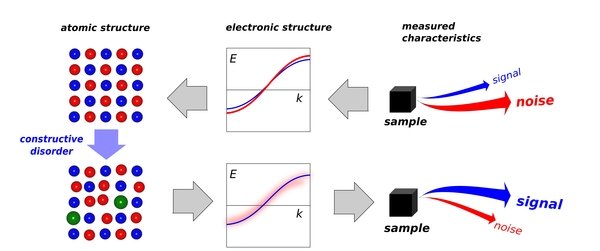
Adjustment of Material Functionalities via Disorder Manipulation
A large number of the Material Science problems can be reduced to a rather generic formulation: how to increase an intensity of the useful properties (“signal“) or how to reduce an intensity of the unwanted ones (“noise”)? The diversity of the degrees of freedom in complex polyatomic systems makes such “signal-to-noise” control rather sophisticated and expensive. Within state-of-the-art technologies operating on the nano-scale, such as spintronics, the quality requirements for the basic elements are often quite stringent: high crystalline order, precision of target compositions, chemical and mechanical compatibility between different materials, precise number of atomic layers, etc. As an alternative, one might turn towards the possibilities provided by disorder. In this context, the desired improvement for a given system can be achieved by introducing a specific type of disorder, which would suppress the “noise” intensity, but preserve the intensity of a “signal”. For instance, on the nano-scale, such engineering requires the established relationships between the “useful” characteristics and the electronic structure, and between the electronic structure and а particular type of disorder. Being connected together, these relationships provide an answer: adjustment of material functionalities via disorder manipulation.
Unfortunately, understanding of disorder and its opportunities for the Material Science has been developing substantially slower compared to the well-defined ideal ordered models. For this reason, many of the potentially interesting improvements, directly manageable for the disorder engineering, have been missed or ignored due to the insufficient knowledge or the lack of necessary tools. In addition, disorder-induced origin of many important effects already widely exploited by the state-of-the-art technologies has been uncovered only recently. One of such illustrations are (In,Ga)N-based LEDs (light-emitting diodes) which widely replace Edison's lamps. Only recently it was shown, that their outstanding luminescent properties are due to inherent disorder of a random alloy. This suggests that a systematic approach to the Material Science, which includes the disorder engineering viewpoint, might cover a wider spectrum of technological problems and address new fundamental aspects.
The key phenomenon produced by disorder is the spatial localization of particles or quasiparticles due to their scattering. Stronger disorder leads to a more frequent scattering of a particle, which spends a longer time within the finite spatial volume. Such scattering-induced localization of different quasiparticles (electrons, photons, phonons, etc.) by disorder always follows the same scenario. Indeed, in order to control the electrical conducance, one needs to engineer the disorder which breakes the translational symmetry, to control the thermoelectic power – the phase disorder, to make a material mechanically harder – to introduce the defects damping the mobility of dislocations, etc. To control and to engineer, one needs a possibility to describe an action of a particular disorder on the properties of a system, and to understand which properties will be affected and which – will not. The related methodology can be subdivided into methods based on the effective mean-field theories (such as CPA and DMFT) and those which explicitly simulate the properties of the large-scale arrays based on parameters obtained either from the first-principles or from the experiment (Monte-Carlo and percolation theory based methods). The examples of the disorder engineering developed in our group can be found in applications to the electronic transport and magnetism.